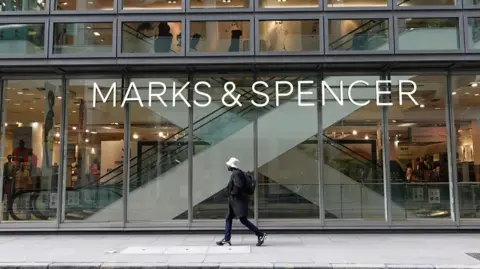In recent events, Marks & Spencer (M&S) shoppers have encountered significant chaos at checkout points due to an ongoing cyber attack that has plagued the company. Reports of issues began surfacing over the weekend, prompting M&S to confirm on Tuesday that they were grappling with a “cyber incident.” By Wednesday, the retailer communicated to the BBC that its customer-facing systems had returned to normal functionality, which instilled some hope among consumers.
However, despite this claim, M&S later disclosed that it had to take several of its systems offline in a bid to manage the situation proactively. This precautionary measure led to the suspension of contactless payment processing and disruptions to the collection of click-and-collect orders at various store locations. Additionally, the retailer warned customers of possible delays in online order deliveries, which further fueled frustration among shoppers.
As of the latest updates, the ability to execute contactless payments has reportedly been reinstated, though many customers have expressed skepticism about its reliability. Staff members at M&S locations witnessed the repercussions of this payment system disruption firsthand. For example, in London’s Euston station, staff were forced to announce that only cash transactions were being accepted, as the payment system had gone offline. Similar scenes played out in Glasgow, while a store at Edinburgh Haymarket appeared to close earlier than usual due to these complications.
M&S explained that the decision to transition some processes offline was made to ensure the safety of its employees, partners, suppliers, and the overall business. Despite this upheaval, stores remained operational, and customers were still able to shop via the M&S website and mobile app. Nonetheless, confusion reigned on social media platforms among customers seeking clarity on the situation.
While M&S attempted to address customer inquiries on X, the platform previously known as Twitter, contradictions arose regarding the status of contactless payments. One customer countered the company’s assurance, stating that cash and chip-and-pin transactions were the only options available. Furthermore, those utilizing the click-and-collect service were advised by M&S not to travel to stores until they received their “Ready To Collect” email. After receiving this notification, several customers expressed their own frustrations when staff members claimed they were unable to retrieve a certain item—a paradox that aggravated the issue.
Although M&S has refrained from providing detailed information about the cyber attack, it is not uncommon for companies to take such measures in response to ransomware allegations. On Tuesday, the retailer communicated to its investors that external cybersecurity experts had been hired to aid in investigating and managing the breach. M&S emphasized its commitment to safeguarding its network and maintaining customer service throughout this ordeal.
Moreover, the incident has been reported to the National Cyber Security Centre (NCSC), which affirmed to the BBC that they are engaged in assisting M&S in their response to the cyber incident. The National Crime Agency has also been involved, with its officers collaborating with both the NCSC and M&S to deepen their understanding of the incident and provide necessary support.
In summation, the chaos inflicted upon M&S customers amid this cyber attack has resonated far beyond a single incident, rendering shoppers frustrated and confused as retailers attempt to manage the fallout. The ongoing efforts by M&S to restore normalcy while ensuring customer safety underscore the challenges businesses face today in navigating the intricacies of cybersecurity threats. This situation serves as a pertinent reminder of the importance of robust cyber defenses, especially in an age where digital transactions dominate.



